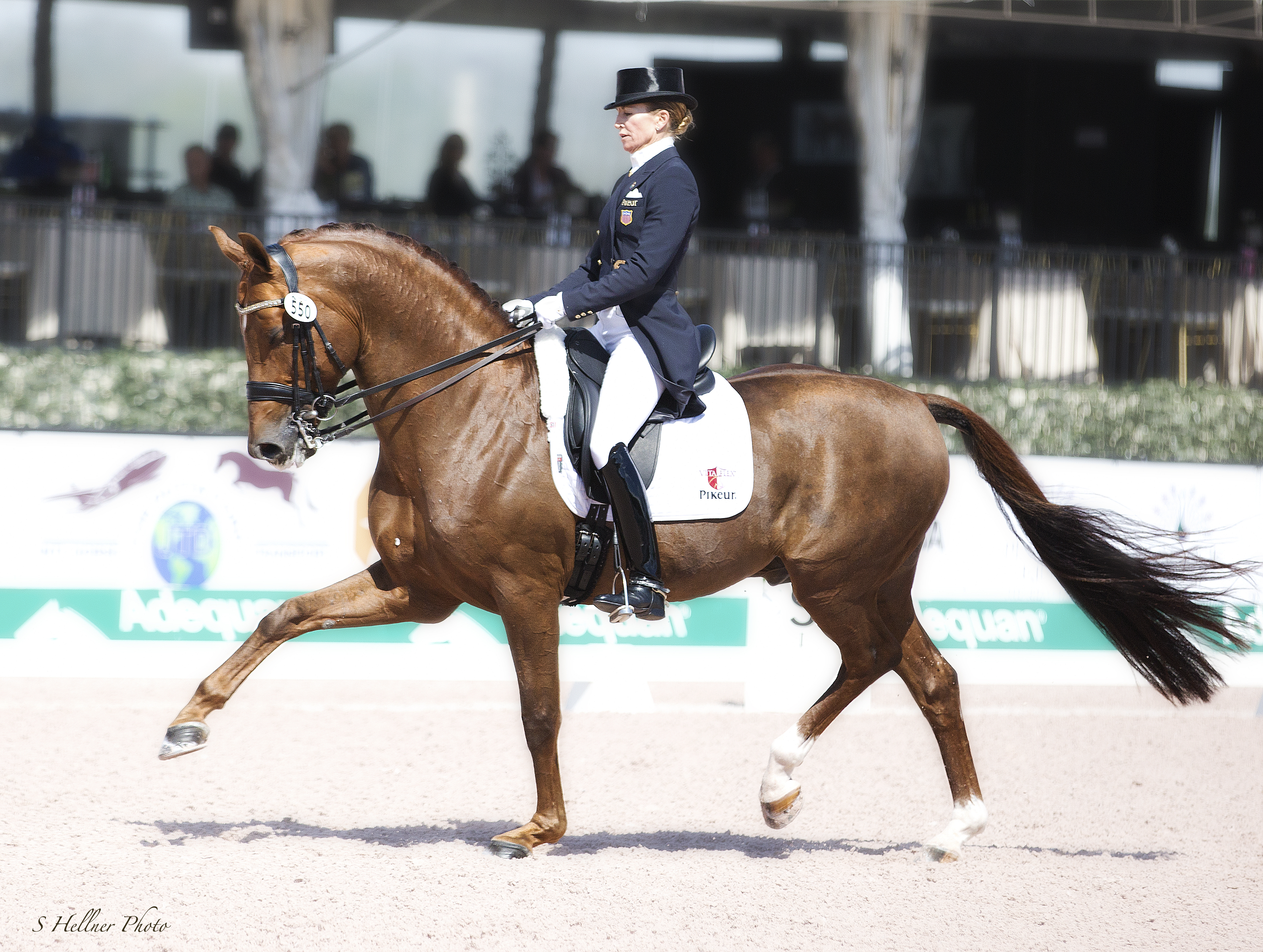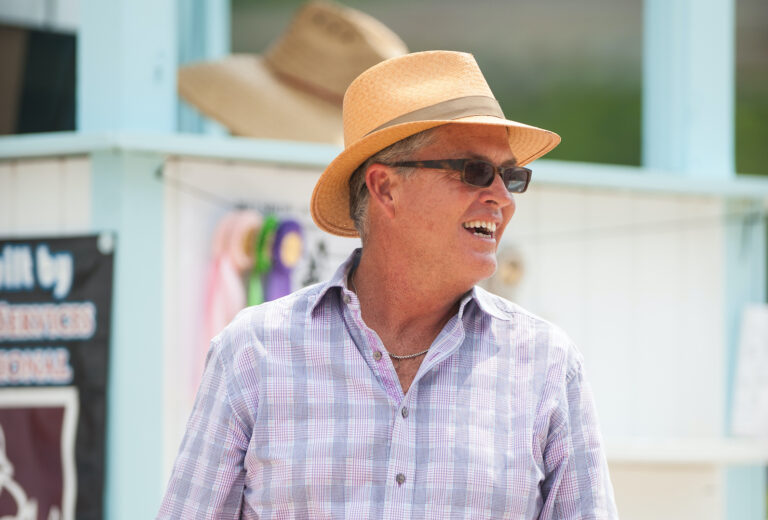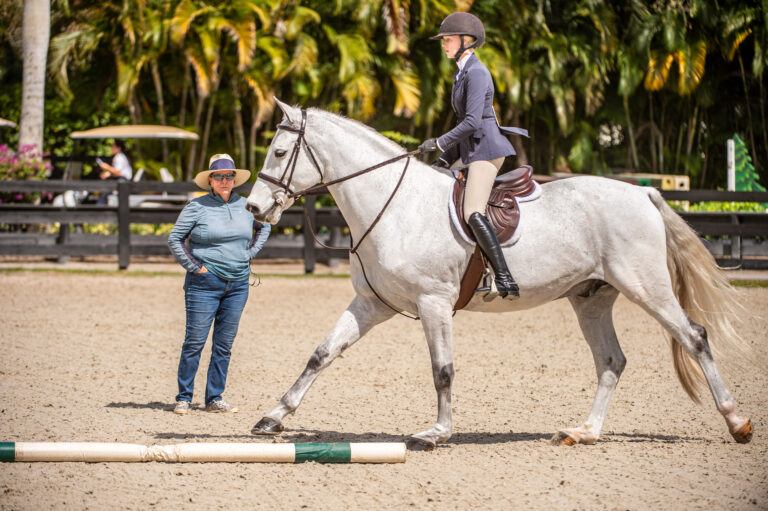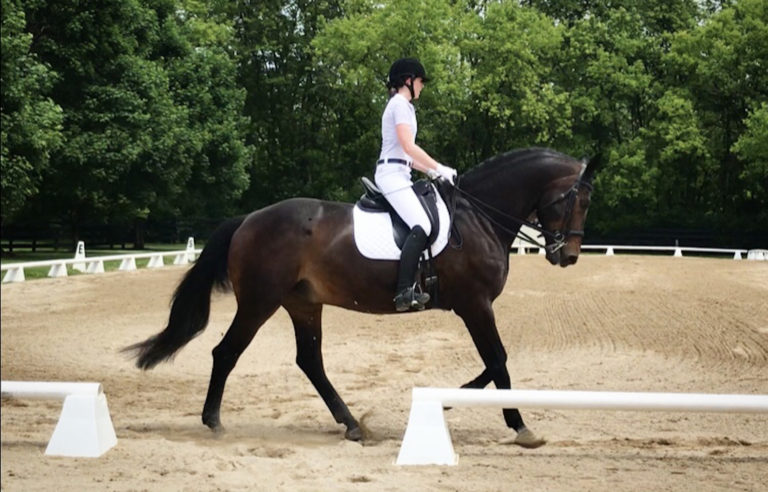
The best way to learn a new language is to immerse yourself completely in the culture. That’s exactly how Lisa Wilcox pursued her classical dressage education. Over the past 25 years, she has followed her dreams from Colorado to California, Denmark, Germany, Switzerland and, finally, back to America. After holding some of the most coveted training jobs in Europe, she’s now passing her hard-earned knowledge on to as many horses and riders as possible in the U.S.
Seeking Wisdom from the Masters
Lisa and her six brothers and sisters learned to ride Western from their father, an Air Force captain. She remembers, “He was always telling us to ‘Sit up straight! Shoulders back!’ We walked around like I’m riding around now.”
Lisa was involved in Pony Club and then eventing, which turned her on to dressage. Riding with German dressage trainer Jan Ebeling in Colorado led to her move to California, where Jan is based, and Lisa married him in 1991. They later divorced, but Jan trained Lisa up to the Grand Prix level and, perhaps more importantly, helped her arrange a trip to Germany to work with the late dressage master Herbert Rehbein.
That taste of world-class instruction convinced Lisa to pull up roots and move to Europe, where she could fully immerse herself in the classical dressage system. A friend of Herbert’s found her a job in a sales and breeding barn in Denmark, where she began to develop a reputation for presenting stallions skillfully. That led to another job at a stud farm in northern Germany. Meanwhile, she enrolled in language classes—she now speaks German fluently—and classes to qualify as a breeding professional. (In Germany, anyone who collects semen from stallions and inseminates mares must be licensed.) Later on, she passed the professional horse trainer, or Bereiter, and riding-instructor, or Reitlehrer, exams.
The Job of a Lifetime
Lisa’s hard work paid off in 1997, when a judge she’d taken lessons from mentioned her to Gudula Vorwerk-Happ, owner of Gestüt Vorwerk, one of Germany’s best-known Oldenburg stud farms. Gudula was looking for a new head trainer and invited Lisa to try out for the job. The tryout itself was unforgettable: She rode one of Germany’s most popular young dressage sires at the time, Rohdiamant, a son of Rubinstein.
Lisa got the job and, for the next seven years, rode nine stallions a day and showed almost every weekend. “In the summertime, we didn’t have days off,” she says. She trained daily under the watchful eye of Ernst Hoyos, a 29-year veteran of Vienna’s Spanish Riding School. Lisa explains, “The Spanish Riding School was like Ernst’s laboratory. He worked with and studied so many horses there, teaching them the high collection for the ‘jumps’—the courbette, capriole and levade. And he used that knowledge and experience to take the classical riding system and refine it.”
Ernst taught Lisa how using her weight aids in concert with her other aids allowed her mounts to stay supple and loose in their rib cages. As a result, they moved more freely and expressively than they would if she resorted to heavy lower-leg pressure and spurring. In this way, she could strive to become what she considers the ideal dressage rider: “a balanced ballerina rider, who can use the least pressure and produce the most expression.”
Lisa won countless ribbons with Gestüt Vorwerk’s stallions. In 2000, she and Roh- diamant’s full brother Royal Diamond won the 6-year-old title at the Bundeschampionat (the national young horse championships). Two years later, she and Relevant, another Rubinstein son, competed for the U.S. at the World Equestrian Games, where they won team silver and placed fifth individually. The following year, Relevant and Lisa won the individual silver medal at the Open European Championships. Their magical partnership continued with stellar performances in the 2004 Olympics, which earned the U.S. a team bronze.
Under the Magnifying Glass
As intense as it was to show in front of the world’s top judges, Lisa felt even more pressure performing for Gestüt Vorwerk’s potential customers: mare owners. “They’re way more critical than those five judges in your five-star CDI. You put a lot of pressure on yourself not to make a mistake because you don’t want people to think, ‘Oh, this is not a good stallion. He’s having mistakes in the piaffe’ or ‘He’s having a hard time in the transitions.’ Breeding stallions in Europe is a really competitive business. We had busloads of people coming in and watching us train all the time. We were always under a magnifying glass.”
The stallions’ semen was collected every morning during the spring, so Lisa wasn’t allowed to take them too far away from the farm for shows. The exception was Norten-Hardenberg, which had a breeding shed and laboratory on the showgrounds. Lisa says, “I’ll never forget [Olympic gold, silver and bronze medalist] Ulla Salzgeber asking me, ‘Where are your stallions going?’ I replied, ‘Oh, they’re being collected in that shed over there—and then they’ll be braided and tacked up to compete in either the Grand Prix or Prix St. Georges.’ Ulla looked at me like I had 10 heads. And I said, ‘It’s OK, some of them are better for it. It takes a little edge off.’”
Managing the stallions at home was challenging at times. Mares arrived on the property daily to be bred, often accompanied by foals. “And when they’d unload them, sometimes the more independent foals would take off. I’d be trying to make it from the barn to the training hall with a stallion and here comes a foal trotting toward us like, ‘Hi Daddy!’”
Rejuvenation
Being under the magnifying glass for seven years began to take its toll on Lisa. “I loved Gestüt Vorwerk, loved the people there—and I’m so grateful that I had all of that—but my battery was drained. I felt like I was losing my enthusiasm and passion. So it was time to move on to the next chapter. But I didn’t feel like I was ready to go home to America yet.”
Fortunately, Lisa received an offer to train at a low-key sales/training barn near Zurich, Switzerland. “And I thought, ‘Wow, you know what? That’s not a half-bad idea.’ I’m a believer in doors opening for a reason. You just never know what’s going to come your way.”
In this new position, Lisa lived in a little cottage in the mountains. She says, “I felt like Heidi of the Alps. The owner had six wonderful dogs, my little BFFs, who followed me around the ginormous property. The barn and indoor were beautifully designed and surrounded by impeccably manicured lawns, like a Swiss chalet. In the springtime, crocuses, tulips and fruit trees bloomed everywhere. It was spectacular! Right in the middle was an outdoor arena. I would sit on my horses in the midst of all this, just enjoying my riding, no pressure. And that’s really what I needed.”
After a year training in this paradise, she was ready to go home. “It’s like I went to a spa treatment. It was a beautiful, rejuvenating period.”
Homecoming
Lisa moved back to the States in 2006. She decided to start her own training business in Florida, which she considers the country’s mecca of international-level dressage. It would also be the easiest place to travel to Europe for training and competing. She leased a barn near Loxahatchee at first, then later moved to two other barns before landing in her current location at Jacqueline Shear’s Marsh Pond Farm in Wellington.
“It was an adjustment moving back to the States,” she says. From the beginning, she had no shortage of clients, but most of them brought horses they were struggling to ride. “I had a stable full of repair work.” The most common problem she identified was a lack of connection—horses who’d been ridden from front to back, rather than back to front—“locked-up horses with no toplines and big, bulging undernecks, and riders who’d been taught half-halts improperly, who didn’t understand that the most important part of the half-halt is the give. When you compress the muscles, they have to be allowed to respond. When you release your fist, if the muscle relaxes, great! Your half-halt worked. If it doesn’t do anything, you need to come with a little stricter half-halt. But it has to be an impulse. If you hold until you feel a give, they will never give.”
Lisa became a “reconstruction” expert, taking her riders and horses back to fundamentals, no matter what level they were. “I’m unraveling them, teaching them how to get the backs through that connection of the hind leg into the hand. I’m on circles, doing transitions, spiraling in and out. You don’t see any movements. What’s the point? You can’t ride them when the horse is inverted and not connected. So I’m not going to mess with them until I have the horse going properly in both directions over the back and into the outside rein. My students joke that we’re on 20-meter circles the entire time. And they’re right. They always get excited when they get to leave the 20-meter circle.”
Most of the training holes Lisa observes in the U.S. stem from an impatience to progress quickly up the levels and do the movements. She reminds her students that patience and trust in the classical training system always produce the best results in the end. “I just say, ‘Take a deep breath. We’re in it for the long haul. First we have to gymnasticize this horse, get him over the back, not inverted, before we can put him in the half-pass or the pirouette or do tempi changes.’”
Oftentimes, she adds, this training transforms horses in ways people don’t expect. For example, she’s trained Jaqueline’s 11-year-old Belgian Warmblood gelding Galant since they imported him as a 4-year-old. The plan was for Jacqueline to ride him eventually, but he was too much for her at first. So Lisa brought him along gradually. At age 6, she says, the 17.3-hand horse was “a big boy, gangly and not expressive. Nobody looked twice at him. In the Prix St. Georges, still nobody gave him a second glance. But with the development of collection through the piaffe and passage in the Grand Prix, he started to gain suspension in his gait. People couldn’t believe it was the same horse.”
Lisa and Galant won the World Cup Freestyle and Grand Prix at the Adequan Global Dressage Festival in January. Then they posted the second-highest Grand Prix score at the Nations Cup in Wellington in March. Lisa then turned the reins over to Jacqueline. “And she’s having a ball with him,” she says. “I don’t think there’s a day she doesn’t ride him and say to me, ‘I feel like crying, this is so fun!’ That makes me very happy.”
Superstars in the Making
Finding sponsorship to support Lisa’s dreams of riding on future Olympic and World Equestrian Games teams is more difficult here in the States than it was in Germany, but she has persevered nevertheless. She’s come close several times: placing eighth in the 2008 Olympic selection trials with Janet Bell and Tom Benson’s Dutch Warmblood mare Naomi and being named the second reserve for the 2014 World Equestrian Games team with Betty Wells’ Hanoverian gelding Denzello, a Rohdiamant grandson. Sadly, her most recent Olympic hopeful, Horses Unlimited’s homebred stallion Pikko del Cerro HU (also a Rohdiamant grandson), with whom she won the 2012 USEF Developing Horse Grand Prix Championships, had to be retired last year due to an injury.
Undaunted, Lisa is now excited about another Horses Unlimited homebred stallion, Gallant Reflection HU, nicknamed “Reef.” (You guessed it, he’s another Rohdiamant grandbaby.) Among many other accolades, he won the 2016 Palm Beach Derby National USEF Developing Horse class. Only 8 this year, he’s already schooling all the Grand Prix movements. “He’s still immature and lacking strength, but the talent is there. You can see the sparkle.” She adds that Anne Sparks, CEO of Horses Unlimited, “is the only owner I have who just gives me horses and goes, ‘Get on with them, compete them.’” Anne funds what she can, but she and Lisa have to get creative to meet the expenses of international campaigns. Grants from The Dressage Foundation covered Lisa’s recent trips to compete in Europe.
The Stallion Whisperer
Although Lisa has been very successful on mares and geldings, she still has a weakness for stallions. “I’m drawn to their playful energy, expression and charisma. Even though they can be knuckleheads, I love them. They talk to you with their eyes. Cerro would stare you down and draw you in like a magnet. Reef talks to me—he goes, ‘Hoo, hoo … hoo, hoo, hoo.’ And I’ll think, ‘My heart can’t take it!’
“But they’re all different, just like humans. Cerro was the tough guy, the Harley-Davidson rider. Reef is Mr. Intellectual, the guy with the ascot, a little pipe and reading his book. He’s like, ‘I’ve read everything we’re doing today. I got it.’”
Lisa’s American clients give her more leeway in managing their stallions than she had at Gestüt Vorwerk. With many of them, she can prioritize their competition schedules above breeding. They’re collected offsite and Marsh Pond is situated on a quiet dirt road, “so there’s never a ton of commotion that would create excitement.”
With her extensive stallion-training experience, it’s no surprise that Lisa’s earned a reputation as somewhat of a stallion whisperer. Top riders of multiple disciplines have asked her for help with their stallions. Among these is show jumper Margie Engle, who recently asked Lisa for help on the flat. “I love Royce [a stallion Margie competes at the grand prix level]!” Lisa says. “I ride him at her barn, training to get him into the outside rein correctly and bending and over the back more than he was—which makes him a much more rideable horse. Margie can be a lot faster now because she can turn better.”
The stallion Lisa is most excited about right now was just born this spring. In another fortuitous twist of fate, just after Cerro’s retirement was announced, a girlfriend offered her broodmare to Lisa to breed to him. “It was divine intervention. I have a miracle baby,” Lisa says proudly. “He’s the most magnificent colt you’ve ever seen in your entire life. I call him Pírate Tesoro [pronounced “Pee-RAH-tuh Tay-ZORE-oh”], which means pirate treasure.”
Finding a New Life Balance
In the meantime, Lisa is committed to the new goal she gave herself when she returned to the States 11 years ago: having more balance in her life. Although her training business is less stressful than her job at Gestüt Vorwerk, she still rides as many as 15 horses a day in the busy winter season. “But I live in a resort atmosphere. My fiancé [Cass Riese] and I live on the Intracoastal Waterway in Florida. I can look out my window at the water and palm trees and go to the beach whenever I want to. On Mondays, which is my day off, we take the boat out and go diving. So I am constantly refreshing myself.”
This article was originally published in the September 2017 issue of Practical Horseman.










